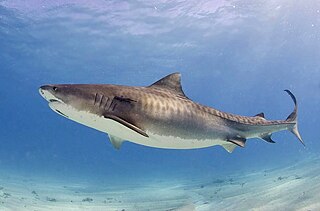
The tiger shark is a species of ground shark, and the only extant member of the genus Galeocerdo and family Galeocerdonidae. It is a large macropredator, with females capable of attaining a length of over 5 m. Populations are found in many tropical and temperate waters, especially around central Pacific islands. Its name derives from the dark stripes down its body, which resemble a tiger's pattern, but fade as the shark matures.

Galeocerdo is a genus of ground shark. Only a single species, G. cuvier, the tiger shark, is extant. The earliest fossils date back to the early Eocene epoch, (Ypresian), around 56–47.8 Million years ago. While historically considered a member of the requiem shark family Carcharhinidae, it is currently considered to be the only member of the family Galeocerdonidae. While this genus was historically considered diverse, including 21 extinct species, morphometric analysis conducted in 2021 suggested that the diversity of the genus included only 5 extinct species much lower than previously assumed. The oldest fossils of the extant G. cuvier date to the middle Miocene.

Palaeoniscum is an extinct genus of ray-finned fish from the Permian period (Guadalupian-Lopingian) of England, Germany, Turkey, North America and Greenland, and possibly other regions. The genus was named Palaeoniscum in 1818 by Henri Marie Ducrotay de Blainville, but was later misspelled as Palaeoniscus by Blainville and other authors. Palaeoniscum belongs to the family Palaeoniscidae.

Physogaleus is an extinct genus of small requiem shark that lived from the Late Paleocene to Miocene epochs.

The Choptank Formation is a geologic formation in Virginia and Maryland. It preserves fossils dating from the Miocene epoch of the Neogene period.
The Piney Point Formation is a geologic formation in Virginia. It preserves fossils dating back to the Lutetian Stage of the Eocene Epoch of the Paleogene period.
The Nestucca Formation is a geologic formation in Oregon. It preserves fossils dating back to the Bartonian to Priabonian stages of the Eocene period.
The Temblor Formation is a geologic formation in California. It preserves fossils dating back from the Late Oligocene to the Middle Miocene of the Neogene period. It is notable for the famous Sharktooth Hill deposit.
The Tirabuzon Formation is a geologic formation in Mexico. It preserves fossils dating back to the Neogene period, Pliocene epoch.
The Carrillo Puerto Formation is a geologic formation in Mexico. It preserves fossils dating back to the Late Miocene to Early Pliocene of the Neogene period.
The Chagres Formation (Tc) is a geologic formation in the Colón Province of central Panama. The sandstones and siltstones were deposited in a shallow marine environment and preserve fossils dating back to the Middle to Late Miocene period.

The Leitha Limestone is a geologic formation in Austria, Czech Republic, Hungary and Poland. It preserves fossils dated to the Middle to Late Miocene period.
The Weissenegg Formation is a geologic formation in Austria. It preserves fossils dating back to the Miocene period.

Galeocerdo alabamensis is an extinct relative of the modern tiger shark. Nomenclature of this shark has been debated, and recent literature identified it more closely with the Physogaleus genus of prehistoric shark, rather than Galeocerdo. The classification of Physogaleus is known as tiger-like sharks while Galeocerdo refers to tiger sharks. In 2003, P. alabamensis was classified as Galeocerdo. However, in 2019, they were proclaimed to be more morphologically similar to the genus Physogaleus. This definition was based primarily on tooth shape, as the majority of information on P. alabamensis is a result of studying tooth fossils. Distinctions between Physogaleus and Galeocerdo are difficult with extinct sharks from the Oilgocene/Miocene as there is little paleobiological information allowing for hard conclusions.
The Langental Formation, also spelled as Langetal Formation, is a Late Eocene geologic formation cropping out in the Sperrgebiet, ǁKaras Region of southwestern Namibia. The siltstones and sandstones of the formation were deposited in a shallow marine environment. The Langental Formation was deposited under hot and humid conditions. The formation overlies the Silica Beds unit and is overlain by the Blaubok Conglomerate. The Langental Formation provides many fossil invertebrates and fish.
The Onzole Formation is an Early Pliocene geologic formation in the Borbón Basin of northwestern Ecuador. The formation consists of a shallow marine sandstone member containing many fish fossils, among which megalodon, and a deep water member comprising tuffaceous shales and mudstones containing gastropods, bivalves and scaphopods.

The Calvert Formation is a geologic formation in Maryland, Virginia, and Delaware. It preserves fossils dating back to the early to middle Miocene epoch of the Neogene period. It is one of the three formations which make up the Calvert Cliffs, all of which are part of the Chesapeake Group.
Galeocorax is an extinct genus of mackerel sharks that lived during the Late Cretaceous. It contains a single valid species, G. jaekeli, that has been found in Europe and North America.

Galeocerdo latidens is extinct species of tiger shark, that lived during in Paleocene and Middle Miocene periods, from 59.2 to 11.608 millions years ago. The species lived in North America, Europe, Africa, and Russia.








